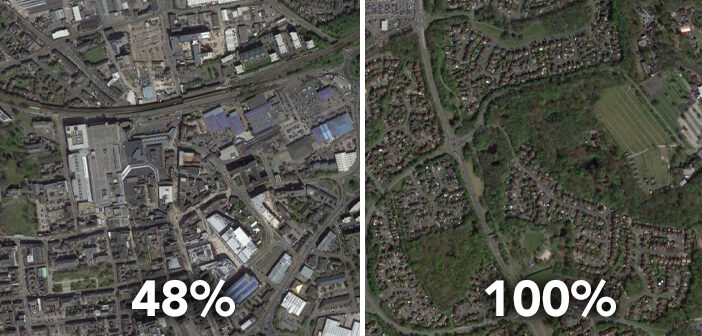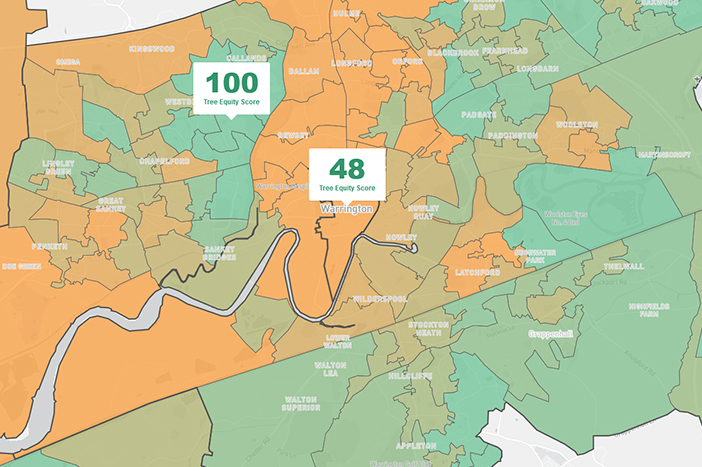PEOPLE living in less affluent areas have lower levels of tree cover and a higher risk of health problems from poor air quality a new online ”tree equity” map reveals.
The online map which for the first time shows inequalities in urban tree cover across the UK shows how less affluent areas have fewer trees and are missing out on their essential health benefits like cleaner air.
The map, not surprisingly shows Warrington town centre as having the lowest level of tree cover, with a rating of 48 per cent, compared to the Twenty Acre Wood area of Old Hall and outlying areas like Lymm and Gorse Covert with 100 per cent!
Neighbourhoods with the highest income levels generally have more than double the tree cover per person than less affluent neighbourhoods and have nearly 20% less of the toxic pollutant nitrogen dioxide (NO2).
In England, regional differences are present, with the ten local authorities with the highest scores in the south and the ten with the lowest scores in the north.* Some coastal areas also have lower levels of tree cover.
The news comes with the launch of a new free interactive tool which uses new tree canopy data from Google and six climate, health and socioeconomic indicators to generate a score from 0 to 100 for most urban neighbourhoods in the UK, known as the “Tree Equity Score”(TES). It shows in areas of lower tree cover there is direct link to more pollution and poorer air quality.
The Woodland Trust encourages everyone to find the Tree Equity Score for their area and urges governments – nationally and locally -to integrate the Tree Equity Score into the policies and plans to ensure this disparity is tackled.
First launched by American Forests in the US in 2021, the Tree Equity Score has just launched in the UK in a partnership between American Forests, the Woodland Trust and the Centre for Sustainable Healthcare. The UK is the first country that Tree Equity Score has expanded to.
Dr Darren Moorcroft, CEO at the Woodland Trust, said this is a “breakthrough” when it comes to targeting resources to areas critically in need of more trees.
He said: “This is a breakthrough moment for trees in the UK. For the first time everyone can see an inequity that is hidden in plain sight – access to the essential benefits of trees. Tree Equity Score shows that there are major differences in levels of tree cover between neighbourhoods and that these often follow socio-economic trends. Tree Equity Score is a tool for action to start addressing this inequity and ensure the essential benefits of trees can improve public health and climate resilience for all.
“More than 34,000 urban neighbourhoods are covered by the Tree Equity Score meaning that nearly 80% of the population can go online and find their score.
“There are numerous underlying reasons for tree inequality, and it is a serious problem in need of immediate solutions. We believe the tool will inspire people to get involved with local projects to plant and care for urban trees. We are calling on national and local governments to integrate tree equity into national and local policies and plans, and to fund and recruit more tree officers to address tree inequality.”
Benita Hussain, Tree Equity lead at American Forests, said:“This program symbolises a major step in our mission to ensure equitable access to urban forests globally.
“In the US, we’ve seen how data-driven strategies can transform communities through urban forestry, enhancing not only environmental health but also social wellbeing. For the first time, differences in levels of tree cover in towns and cities across the U.K. have been mapped for anyone to see.”
The Centre for Sustainable Healthcare works with healthcare professionals and the wider public to help develop the knowledge, skills and tools people need to play their part in the transformation to sustainable healthcare. “We know that trees have a huge positive impact on people’s health and wellbeing, and healthcare providers are uniquely placed to champion access to these benefits,” said Sarah Jordan, Director of Green Space for Health at the Centre for Sustainable Healthcare. “From individuals through to anchor institutions such as the NHS, Tree Equity Score can be used at any scale to help get trees where they’re needed most and reduce health inequalities.”
The UK Tree Equity Score reveals disparities including:
– Neighbourhoods where tree cover per person is highest have roughly 30% less NO2 pollution and 10% less particulate matter pollution than neighbourhoods where tree cover is lowest.
– UK-wide, neighbourhoods with the highest income levels have more than double the tree cover per person than the less affluent neighbourhoods and have nearly 20% less nitrogen dioxide (NO2) air pollution.
-Lower tree cover has a dramatic effect on neighbourhoods for example those with the highest number of trees have up to 330% less air pollution and are 4 degrees Celsius cooler during a heat wave than neighbourhoods where tree canopy is lowest.
– UK-wide, neighbourhoods with fewest people identifying with minority ethnic groups have roughly double the tree canopy per person than neighbourhoods with the most, and experience 50% less NO2 air pollution, 20% less particulate matter (PM2.5) air pollution and are 5 degrees C cooler.
– Neighbourhoods where tree cover per person is highest have roughly 30% less NO2 pollution and 10% less particulate matter pollution than neighbourhoods where tree cover is lowest.
In the UK, a number of cities are already adopting Tree Equity, including Birmingham and Belfast which have recently included actions on Tree Equity in city-level plans to increase tree cover. The tool will also be demonstrated at COP28, the UN climate conference on 8-9 December in the United Arab Emirates, with the goal of encouraging more cities throughout the globe to adopt the tool.
Trees improve air quality by removing particulate air pollutants, as well as cool city streets by providing natural shade. Research from the U.K. Environment Agency shows air pollution is the single biggest environmental threat to health in the UK, shortening tens of thousands of lives each year** and heat-related deaths are increasing annually***.
Doubling tree cover could cut the number of heat-related deaths in European cities during summer months by nearly 40 percent, according to a modelling study by the Barcelona Institute for Global Health.
The Office for National Statistics recently estimated the annual economic value of broadleaved woodland in regulating air pollution in the UK was over £1bn – the highest of any habitat. Of this, the value of urban trees contributed more than half.
American Forests’ Tree Equity Score tool has been in use in the U.S. for over two years and is integral to its plans to advance Tree Equity in 100 cities by 2030. In September, 2023 in the U.S., the Biden-Harris administration announced over $1 billion in grants to increase equitable access to trees as part of the Inflation Reduction Act and President Biden’s commitment to improve environmental justice.
To find out your neighbourhood’s Tree Equity Score, visit: www.woodlandtrust.org.uk/treeequity






1 Comment
And it will only get worse the amount of planned housing being built in the town centre